The good beginning makes the good ending, so it goes without saying that choosing a system and style of management smart is the key to success when developing software. These days there are tons of approaches each having its pluses and minuses.
It is essential to choose the smart strategy at the very beginning as well as defining your goals, objectives, budget and deadlines. That is why, we have investigated the issue to provide you with the ultimate guide on what methodology to use.
History of Software Development Methodologies
It all began in 1950s and keeps on evolving, new approaches appearing until today. To put it shortly, throughout every decade, a particular methodology was supposed to best suit the needs of the time and perfect apt to solve the problems of the then days. Every new system was meant to make the development more productive and boost the desired results.
Types of Software Development Methodologies
So what is the software development procedure all about? It has to do with dividing the working process into various stages, as well as delegating various task among different employees. What is more, it presupposes taking some specific approach to organizing and optimizing the whole development process and managing the team work. That is why, there are various types of methodologies aimed at improving SDLC. So here are the top ones we are going to examine.
Software Development Methodologies List
In the list below we have presented 12 most common methodologies, the gist of every approach, their advantages and disadvantages.
1. Agile Development Methodology
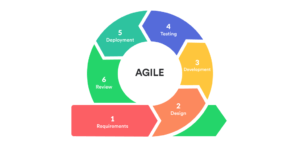
Gist: The main focus of this methodology is the project/product itself. That is why, it presupposes various constant alterations based on users and customers feedback, as well as internal changes related to the work of engineers. Agile software development methodology is free of rigid frameworks on the one hand. While, on the other hand, the working process is divided into short time boxes, thus offering the real results and feedbacks truly fast.
Benefits: Problems are fixed at the early stage, so the quality of the final product is often top-notch.
Drawbacks: It is easy to get off track with all the constant changes and amendments aimed at improving the product.
2. Waterfall Development Methodology
Gist: The absolute opposite to the previous approach, this methodology is strict and linear. A new stage can only be started if the previous one is completed. In other words, each phase gradually flows into the next one. What is more, there is no going back to the previous stage. This approach is easy to understand as it presupposes a strict sequence of completed tasks. Waterfall methodology is often regarded as a classic representation of software development.
Benefits: It is simple, functional, gradual and analytical.
Drawbacks: Works good with exact requirements and needs only. Weak for long or ongoing projects.
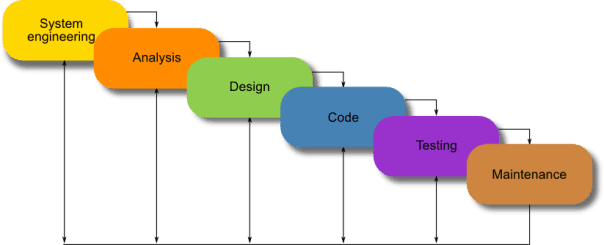
3. Extreme Programming
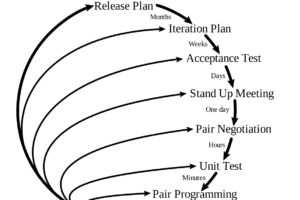
Gist: A perfect approach for unstable projects, as it implies involving the customer as much as possible. What is more, it presupposes considerable flexibility. Extreme programming methodology is believed to boost the quality of software owing to its ability to adapt to dynamic changing demands. In addition to that, constant feedback and communication is the key to efficient and happy team environment.
Benefits: Significant customer involvement results in high quality products. Immediate feedback and courage to take difficult decisions.
Drawbacks: Efficiency is much dependent on the people involved. Vague and unknown future results.
4. Lean Development
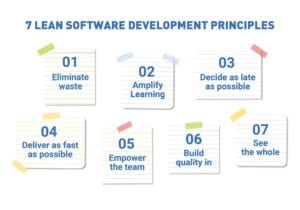 Gist: Value for the client is the essential core element the whole approach revolves around. If something is worth, it should be done immediately; if not, it should be removed. Lean development methodology focuses a lot on losses reduction. That is why, the whole project is examined significantly beforehand to eliminate any wasted time or money. As value is the core component, feedback plays the crucial role itself, so that the actions are taken fast.
Gist: Value for the client is the essential core element the whole approach revolves around. If something is worth, it should be done immediately; if not, it should be removed. Lean development methodology focuses a lot on losses reduction. That is why, the whole project is examined significantly beforehand to eliminate any wasted time or money. As value is the core component, feedback plays the crucial role itself, so that the actions are taken fast.
Benefits: Perfect for low-budget project and rigid time limitations.
Drawbacks: Success is much dependent on the working capacity of a team. Too much of a flexibility can lead to loss of a focus.
5. Prototype Model
 Gist: Based on the waterfall approach and having a significant focus on customer feedback. There are some initial requirements, developers provide samples, and only after customers evaluate the functionality of samples, the final development begins. The gist of this method lies in the name itself – prototype methodology. In other words, before getting down to business, there will be painstaking research and prototyping to avoid unnecessary risks.
Gist: Based on the waterfall approach and having a significant focus on customer feedback. There are some initial requirements, developers provide samples, and only after customers evaluate the functionality of samples, the final development begins. The gist of this method lies in the name itself – prototype methodology. In other words, before getting down to business, there will be painstaking research and prototyping to avoid unnecessary risks.
Benefits: Increased chances of top quality functionality and low risks of failure.
Drawbacks: Possible budget increase, as the management cost may go beyond the money limit. Too much of client involvement can affect the process by slowing it down.
6. Dynamic Systems Model
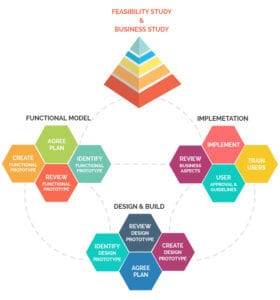 Gist: There are two main focuses: strict time frame and assigned budget. The idea is to manage to provide a successful and effective software within a particular time limit and not exceeding costs. Users involvement is of high importance as well. Dynamic systems model presupposes continuous feedback to deliver maximum functionality within the agreed requirements.
Gist: There are two main focuses: strict time frame and assigned budget. The idea is to manage to provide a successful and effective software within a particular time limit and not exceeding costs. Users involvement is of high importance as well. Dynamic systems model presupposes continuous feedback to deliver maximum functionality within the agreed requirements.
Benefits: Great communication between developers and users resulting in reaching the needed functionality as fast as possible.
Drawbacks: Costs are quite considerable. The approach will not fit and meet the needs of a small organization.
7. Feature Driven Development
Gist: Features are regarded as sort of users feedback. Planning, designing and building is all feature-based. This approach involves iterations to boost functionality and deal with varied complexities. Feature driven development aims at organizing the work of a large number of teams within a big organization.
Benefits: Great dealing with huge projects. The pre-set standards simplify the developing procedure. Enables any developer with appropriate experience and expertise handle the tasks.
Drawbacks: Cannot be applied by small organization. Needs leading developers to monitor the process. Difficult to guarantee the strict deadline.

8. Rational Unified Process
Gist: The idea of this approach lies in having four stages of developing process. ‘During each of the phases, all six core development disciplines take place – business modelling, requirements, analysis and design, implementation, testing and deployment’, according to study.com. The main focus of this methodology is craft an effective software of high quality without expanding the budget and missing the time frame.
Benefits: Reliable and strict documentation. Risks avoidance taking into consideration clients evolving needs.
Drawbacks: Considerably expert developer needed. May be too difficult to make head or tail of the rational unified process model.
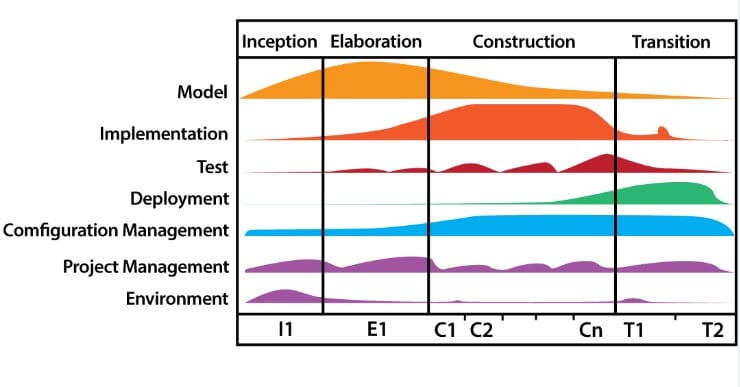
9. Spiral Model
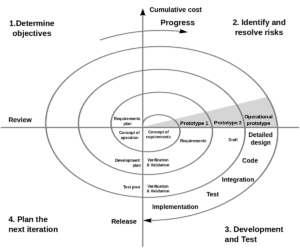 Gist: The main idea is to eliminate the risks at the early stage of the project. The developing procedure goes from smaller level to the big ones gradually. This approach combines waterfall ideas with iterations. Each stage involves setting the goals and receiving feedback from a client. Moving from one phase to another in a spiral model implies completing and removing the risks before moving forward.
Gist: The main idea is to eliminate the risks at the early stage of the project. The developing procedure goes from smaller level to the big ones gradually. This approach combines waterfall ideas with iterations. Each stage involves setting the goals and receiving feedback from a client. Moving from one phase to another in a spiral model implies completing and removing the risks before moving forward.
Benefits: Process of estimating the costs is easy. Iterations help to manage the risks. There is a system of developing procedure, thus progress is achieved fast.
Drawbacks: Danger of failing to meet the agreed budget and time limit. Not suitable for small organizations and projects.
10. Joint Application Development
Gist: This approach implies significant interaction between users, designers and developers. There are workshop sessions to facilitate and increase the developing process. During the session the following people are involved: a facilitator, end users, developers, observers, mediators and experts. What is more, in joint application development there is a considerable focus on eliminating errors at the early stage, thus saving the expenses needed to correct the mistakes later on.
Benefits: Valuable info is achieved within a short time period. Immediate elimination of errors and resolving the differences.
Drawbacks: Can be quite time and energy consuming when it comes to planning. Requires significant budget. Needs highly experienced and expert professionals.
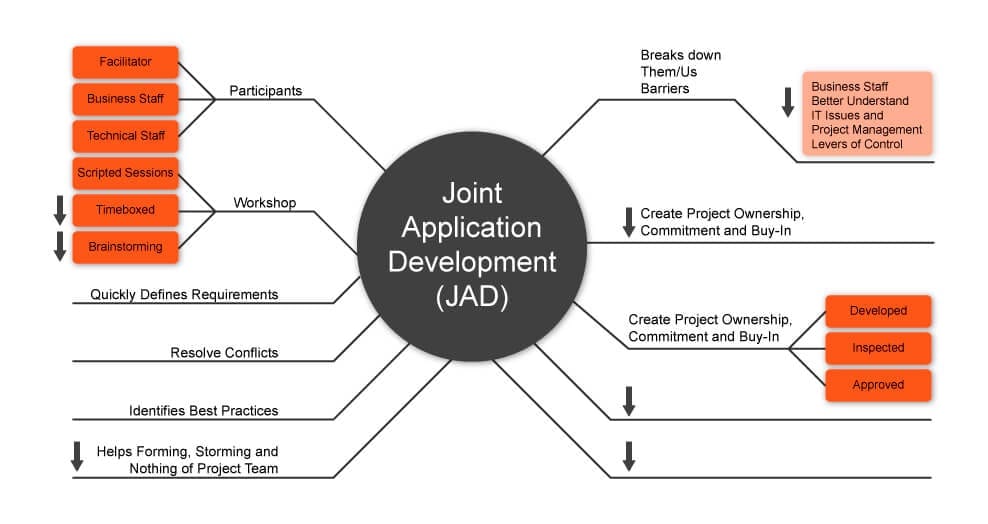
11. Scrum Development
Gist: Easy to understand and effective when it comes to achieving results. The working process is divided into sprints. All the assignments for each sprint are set beforehand and are then discussed after this time period. Thanks to this approach, it is easy to get response to emerging problems early, and as a result solve them immediately. Scrum development methodology is by far the most flexible. For this reason, it easily deals with projects having changing requirements.
Benefits: The team is responsible for decision-making. Light control goes together with constant updating that keeps all of the team always on guard.
Drawbacks: Costs needed can often be uncertain. Big projects cannot be managed with this approach. Only expert professionals can be involved, with no beginners.

12. Rapid Application Development
Gist: It is clear from its name that the main goal of this approach is to achieve fast results. To do so it uses the assistance of other development methodologies. It focuses on fast prototype releases and iterations. As a result, the quick feedback is received, errors are eliminated and the desired results are reached. It is as flexible and adaptable as possible. The main focus is to adjust, so that the software is crafted functional and effective fast. Rapid application development methodology includes 5 stages: analysis and quick design, prototype cycles, testing and implementation.
Benefits: Client is encouraged to take fast reviews. Customers provide constant feedback for improvement.
Drawbacks: Not suitable for small projects. Highly expert employees are required. Too much dependant on team performance.
Final words
To reach the desired results throughout the developing procedure it is essential to choose a suitable and appropriate approach first. Don’t hesitate to dedicate time and energy to define your goals and objectives, estimate your budget and set the time limits. It will help you understand which method to turn to if you want to succeed.
It goes without saying that nothing works 100%. Every system has its benefits and drawbacks that need to be taken into consideration. For this reason, be careful and scrutinize each and every methodology before selecting one. Hope this article was of great help and now you feel more confident what type of approach will be just right for your team.